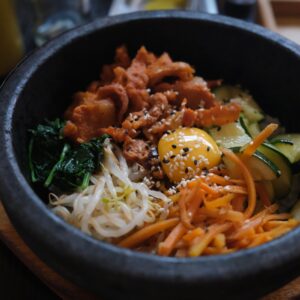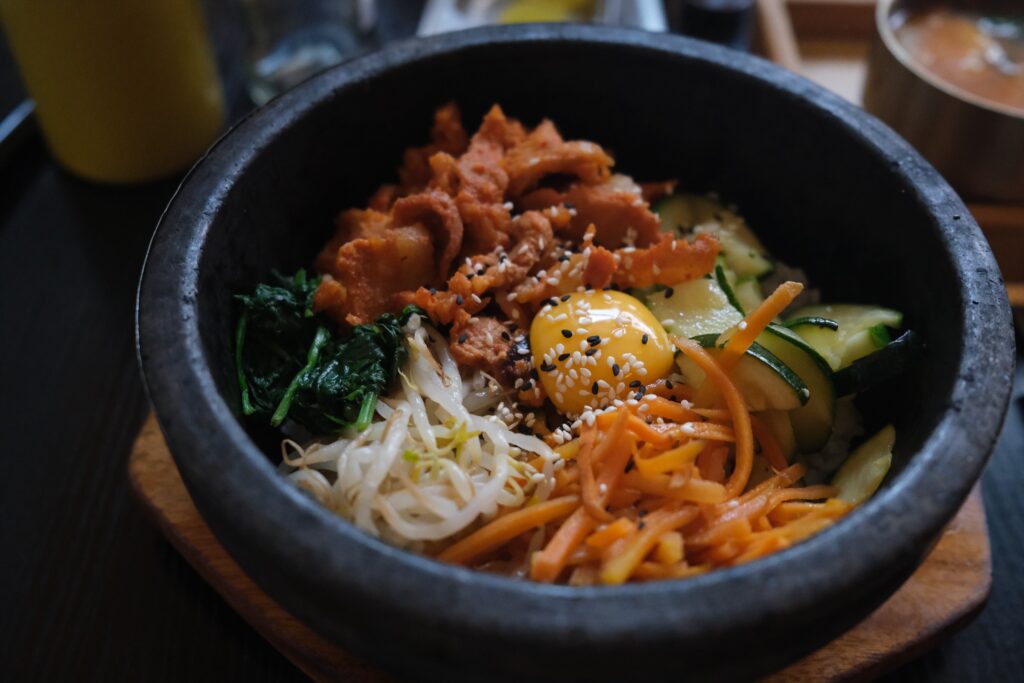
Best Korean Bibimbap Recipe
Equipment
- 1 x Pressure Cooker
- 2 x Bowl
- 1 x Pan
- 1 x spatula
Ingredients
For the Bibimbap Base:
- 2 cups cooked short-grain rice
- 2 cups spinach washed
- 1 medium carrot julienned
- 1 zucchini julienned
- 1 cup bean sprouts blanched
- 1 cup shiitake mushrooms sliced
- 4 eggs optional, for topping
- Sesame oil for drizzling
- Sesame seeds for garnish
- Salt and pepper to taste
For the Bibimbap Sauce (Gochujang Sauce):
- 2 tablespoons gochujang Korean red pepper paste
- 1 tablespoon soy sauce
- 1 tablespoon sesame oil
- 1 tablespoon rice vinegar
- 1 tablespoon honey or sugar
- 2 cloves garlic minced
- 1 teaspoon grated ginger
Instructions
Prepare the Rice
- Cook the short-grain rice. Once cooked, fluff it with a fork and set aside.
- Blanch the spinach in boiling water for about 1-2 minutes. Drain and squeeze out excess water. Season with a pinch of salt and a drizzle of sesame oil. Mix well and set aside.
- Julienne the carrot and zucchini into thin strips. Sauté them lightly in a pan with a bit of oil or leave them raw for added crunch.
- Blanch the bean sprouts in boiling water for about 2 minutes. Drain and season with salt and a bit of sesame oil. Set aside.
- Sauté the sliced shiitake mushrooms in a bit of sesame oil until they are cooked through. Season with salt and pepper.
Prepare the Bibimbap Sauce
- In a bowl, whisk together gochujang, soy sauce, sesame oil, rice vinegar, honey (or sugar), minced garlic, and grated ginger. Adjust the seasoning to your taste.
Assemble the Bibimbap
- Divide the cooked rice among serving bowls.
- Arrange portions of each prepared vegetable and mushrooms on top of the rice, creating a colorful display.
- Optionally, top with a fried or poached egg.
Serve
- Drizzle the Bibimbap sauce over the vegetables and rice.
- Garnish with sesame seeds and an additional drizzle of sesame oil.
- Serve immediately, and instruct diners to mix everything together before eating to enjoy the full range of flavors.
Video
History of Bibimbap: Savoring Centuries of Tradition
Bibimbap, a word that translates to “mixed rice” in Korean, is more than just a dish; it’s a celebration of color, texture, and harmony. Its origins can be traced back to the Joseon Dynasty (1392-1897), where the dish was first mentioned in a cookbook called “Siuijeonseo.” In its early days, Korean Bibimbap Recipe was a simple meal crafted from surplus vegetables mixed with rice and fermented pastes.
As time progressed, Bibimbap underwent a culinary evolution, incorporating diverse ingredients and cooking techniques. The dish became a symbol of balance, representing the Korean philosophy of Yin and Yang through its harmonious blend of flavors and textures. Traditionally served in a hot stone bowl called “dolsot,” the dish showcases the artistry of arranging vibrant vegetables, marinated meats, a fried or raw egg, and a dollop of gochujang (red chili paste) on a bed of steaming rice.
Bibimbap Bowl and Korean Dolsot Bowl: Unveiling the Theater of Flavors
The vessel in which Bibimbap is presented plays a crucial role in enhancing the dining experience. The Bibimbap bowl, with its wide rim, provides a canvas for arranging vibrant ingredients. On the other hand, the Korean dolsot bowl introduces an element of sizzle, enhancing the texture by crisping the rice at the bottom.
Whether you choose the traditional Bibimbap bowl or the theatrical dolsot, each promises a sensory journey through layers of colors and flavors.
Korean Bibimbap Recipe Ingredients
Bibimbap is a harmonious blend of flavors, and the choice of ingredients is key. From crisp vegetables to umami-rich mushrooms, each component plays a unique role in creating the perfect Bibimbap. Gochujang sauce adds a spicy kick, while sesame oil and seeds contribute a nutty depth. The combination results in a flavor palette that transcends borders.
Korean Bibimbap Recipe at Home
Creating Bibimbap at home is not just about cooking; it’s about channeling the spirit of Seoul in your kitchen. The artful arrangement of ingredients, the drizzle of sesame oil, and the final mix before indulging in the symphony of flavors—each step is a celebration of Bibimbap’s Korean roots. Make your kitchen a stage for this Seoulful affair.
Korean bibimbap recipe
Bibimbap has transcended from being a dish to a cultural icon, especially in the eyes of Korean celebrities. The likes of BTS members, Kim Soo-hyun, and Song Hye-kyo have publicly expressed their love for Bibimbap. This star-studded affair adds a celestial touch to Bibimbap’s charm, elevating it to more than just a delightful dish.
As we wrap up our journey through the delectable world of Bibimbap on Desi Streets, we invite you to indulge in the flavors, share the love, and embark on an exciting culinary adventure right from your own kitchen. Did Bibimbap spark a craving for more Seoulful delights, or perhaps you have a unique twist to share? We want to hear from you!
Drop a comment below, sharing your thoughts, experiences, or any variations you’ve tried. Let’s create a vibrant community where food enthusiasts, like you, come together to celebrate the fusion of cultures and flavors. Feel free to hit the like button if you found this exploration enjoyable, and don’t forget to share it with your fellow foodies who might be on the lookout for a Seoulful culinary journey.
Stay tuned for more tantalizing recipes and culinary tales from Desi Street Foods. Our kitchen is always buzzing with excitement, and we can’t wait to bring you more recipes that promise to tickle your taste buds and transport you to different corners of the world.
Keep savoring, keep sharing, and keep discovering the diverse wonders that Desi Street Foods has to offer. Until our next culinary escapade, happy cooking and bon appétit!


